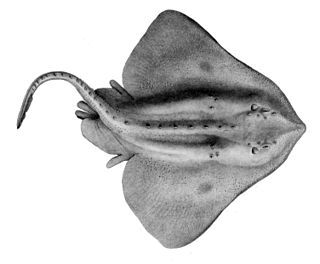
Skates are cartilaginous fish belonging to the family Rajidae in the superorder Batoidea of rays. More than 150 species have been described, in 17 genera. Softnose skates and pygmy skates were previously treated as subfamilies of Rajidae, but are now considered as distinct families. Alternatively, the name "skate" is used to refer to the entire order of Rajiformes.

Rajiformes is one of the four orders in the superorder Batoidea, flattened cartilaginous fishes related to sharks. Rajiforms are distinguished by the presence of greatly enlarged pectoral fins, which reach as far forward as the sides of the head, with a generally flattened body. The undulatory pectoral fin motion diagnostic to this taxon is known as rajiform locomotion. The eyes and spiracles are located on the upper surface of the head and the gill slits are on the underside of the body. Most species give birth to live young, although some lay eggs enclosed in a horny capsule {{Citation needed}}.
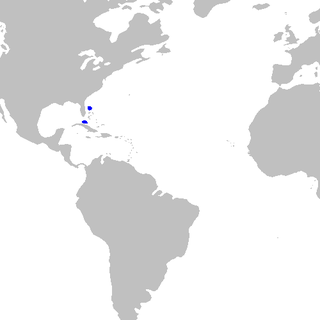
The Bahamas sawshark, Pristiophorus schroederi, is a sawshark of the family Pristiophoridae, found in the western Central Atlantic Ocean from the Bahamas and Cuba at depths of between 400 and 1,000 m. These sharks are at least 80 cm long.
This glossary of ichthyology is a list of definitions of terms and concepts used in ichthyology, the study of fishes.

The blurred lanternshark is a little-known species of dogfish shark in the family Etmopteridae, found around the world in benthic and pelagic habitats from a depth of 110 m (360 ft) to over 1 km (0.62 mi) down. This shark forms the E. pusillus species group with the smooth lanternshark, which are distinguished from other members of its family by having irregularly arranged, flat-topped dermal denticles that give them a "smooth" appearance. Both species are slender-bodied with long heads, two dorsal fins bearing spines, no anal fins, and light-emitting photophores. The blurred lanternshark is larger, reaching 67 cm (26 in) or more in length. This species feeds on small squid, fishes, and fish eggs, and is ovoviviparous. It has been assessed as of Least Concern by the International Union for Conservation of Nature, because of its wide distribution and lack of threat from fishing pressure.

The blacktip sawtail catshark is a species of catshark, and part of the family Scyliorhinidae, found off the coasts of Taiwan and the Philippines. It is demersal in nature and occurs deeper than 60 m (200 ft). Growing up to 46 cm (18 in) long, this slim-bodied species is characterized by its plain brownish dorsal coloration with dark tips on the dorsal and caudal fins, and a prominent crest of enlarged dermal denticles on the upper edge of the caudal fin. It is oviparous, with females producing encapsulated eggs two at a time year-round. The blacktip sawtail catshark is caught incidentally in bottom trawls and used for fishmeal in Taiwan.

The Japanese angelshark is a species of angelshark, family Squatinidae, found in the northwestern Pacific Ocean off China, Japan, and Korea. It is a bottom-dwelling shark found in sandy habitats down to 300 m (980 ft) deep. This species has the flattened shape with wing-like pectoral and pelvic fins typical of its family, and grows to 1.5 m (4.9 ft) or more in length. Its two dorsal fins are placed behind the pelvic fins, and a row of large thorns occurs along its dorsal midline. Its upper surface is cryptically patterned, with numerous squarish dark spots on a brown background.

The deepsea skate is a species of softnose skate, in the family Arhynchobatidae, found in deep water from 362 to 2,906 m, usually on the continental slope. They are distributed from off northern Baja California around Coronado Island and Cortes Bank, north to the Bering Sea, and west to Japan. It is fairly common below 1,000 m, and is taken as bycatch in deepwater trawls and traps. The species name abyssicola comes from the Greek abyssos meaning "bottomless", and cola meaning "living at depths".

The Mekong freshwater stingray, Hemitrygon laosensis, is a species of stingray in the family Dasyatidae, restricted to the Mekong and Chao Phraya Rivers in Laos and Thailand; the occurrence in Chao Phraya is considered an introduction. Measuring up to 62 cm (24 in) across, this ray has an oval pectoral fin disc, a tail with both upper and lower fin folds, and a midline row of spine-like dermal denticles. A characteristic feature of this species is its bright orange underside. The Mekong freshwater stingray preys on invertebrates and is aplacental viviparous. It has been assessed as Endangered by the International Union for Conservation of Nature (IUCN), as it is threatened by overfishing and habitat degradation.

The thornback guitarfish is a species of ray in the family Platyrhinidae, and the only member of its genus. Despite its name and appearance, it is more closely related to electric rays than to true guitarfishes of the family Rhinobatidae. This species ranges from Tomales Bay to the Gulf of California, generally in inshore waters no deeper than 6 m (20 ft). It can be found on or buried in sand or mud, or in and near kelp beds. Reaching 91 cm (36 in) in length, the thornback guitarfish has a heart-shaped pectoral fin disc and a long, robust tail bearing two posteriorly positioned dorsal fins and a well-developed caudal fin. The most distinctive traits of this plain-colored ray are the three parallel rows of large, hooked thorns that start from the middle of the back and run onto the tail.

The broad skate is a poorly known species of skate in the family Rajidae. It occurs at depths of 846 to 2,324 metres, and has been observed via remotely operated underwater vehicle by the Monterey Bay Aquarium Research Institute as deep as 3,167 metres (10,390 ft), making it one of the deepest-occurring skates known. It is sporadically distributed in the Pacific Ocean, from the Gulf of Panama to British Columbia and the Bering Sea, to the Tohoku Slope off northern Honshu and the Okhotsk Slope off Hokkaido. The species name, badia, comes from the Latin batius meaning "brown", referring to its color.
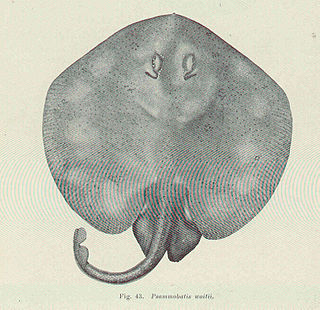
Irolita is a genus of softnose skates in the family Arhynchobatidae, commonly known as round skates. There are two species, both endemic to Australia, found over soft bottoms on the outer continental shelves and upper continental slopes, at depths of 50–200 m for the southern round skate and 142–209 m for the western round skate. The distributions of the two species do not overlap.

Bathyraja mariposa, sometimes referred to as the butterfly skate, is a species of skate found in the Aleutian islands. It is overall a medium-brown color, lacks thorns on the disc and has indistinct thorns on the tail. It was discovered in 2002 during a National Marine Fisheries Service survey, and first described in 2004. The holotype specimen is held at the University of Washington. Its species name "mariposa" derives from the Spanish word for butterfly, although several other species are sometimes referred to as the "butterfly skate."
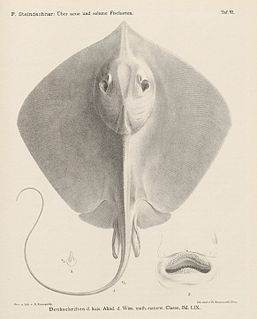
The Chinese stingray, Hemitrygon sinensis, is a little-known species of stingray in the family Dasyatidae, found in the northwestern Pacific Ocean off the coasts of China and Korea. This species is characterized by a band of small dermal denticles running along the upper surface of its diamond-shaped pectoral fin disc, from the snout to the tail spine. It can grow to 40 cm (16 in) across and 82 cm (32 in) long. The Chinese stingray is taken incidentally in bottom trawls and is one of the three most commonly marketed stingrays in China. At present, the International Union for Conservation of Nature (IUCN) has assessed its conservation status as endangered.

The Australian reticulate swellshark is a little-known species of catshark in the family Scyliorhinidae. It is found off the coast of northwestern Australia at depths of 290–420 m (950–1,380 ft). This shark has a stocky body and a short, wide head with a capacious mouth. It is characterized by a striking dorsal color pattern of dark brown lines that trace a series of hollow saddles and narrow rings, on a light background. Like other swellsharks, this species can inflate itself when threatened. Its reproduction is oviparous.

The mottled skate is a species of skate in the family Rajidae. An inhabitant of shallow coastal waters, it is found in the northwestern Pacific Ocean off Korea, Japan, and China. This species grows to 1.12 m (3.7 ft) long and has a diamond-shaped pectoral fin disc with a long snout. It is characterized by a covering of prickles above and below its snout, but not elsewhere on its body, and a dark ring in the middle of each "wing".

The Indonesian angelshark is a rare species of angelshark, family Squatinidae, known only from a few specimens collected from fish landing sites in southern Indonesia. It is thought to inhabit the deep waters of the continental slope. Reaching at least 1.34 m (4.4 ft) long, this species has a flattened, ray-like shape and a well-developed tail and caudal fin. It is characterized by the absences of fringes on its nasal barbels and thorns down the midline of its back, as well as by its relatively plain grayish-brown dorsal coloration with dark saddles beneath the dorsal fin bases and a black leading margin on the underside of the pectoral fins. The International Union for Conservation of Nature (IUCN) has classified it as Critically Endangered due to significant fishing pressure.
The Philippines angelshark is a species of angelshark, family Squatinidae, known only from a 33 cm (13 in) long immature female caught in the Philippines, where it is the only known representative of its family. It has a flattened body and head with greatly expanded pectoral and pelvic fins, and is greenish above with brown spots. Identifying traits of this species include the spiracles, which are more widely spaced than the eyes and bear papillae on the posterior inner rims, and the relative positions of the two dorsal fins. Additionally, S. caillieti lacks fringes on its barbels, enlarged thorns along the middle of its back, and ocelli ("eyespots") on its fins.
The Peruvian skate is a large skate found in the southeast Pacific Ocean, off the coasts of Peru, Ecuador, and Chile. It can grow to an estimated 1.1 metres total length, and 1.25 m across. It is known to be a deepwater species; the holotype was caught at a depth of 908 m (2,979 ft), and is generally found at depths of 600–1,100 m (2,000–3,600 ft). Very little is known about its biology.
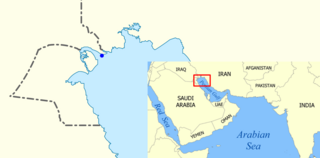
The pita skate is a medium-sized skate in the family Rajidae. The holotype and only known specimen was found in the northern Persian Gulf, in Iraqi waters. It was collected at a depth of less than 15 m (49 ft).


















